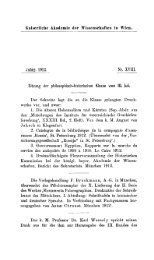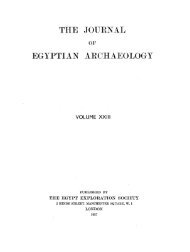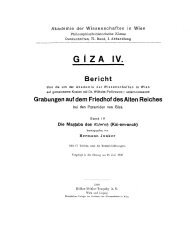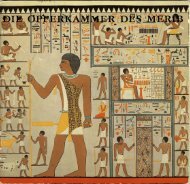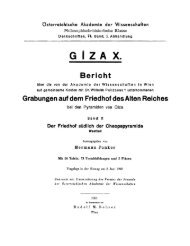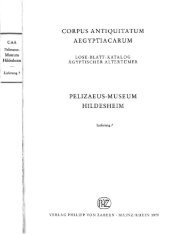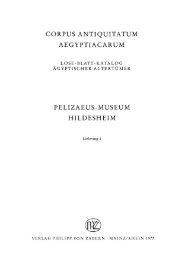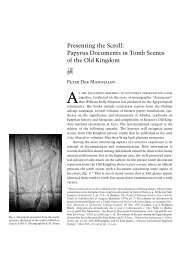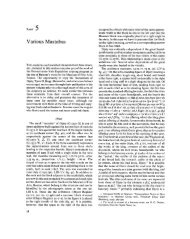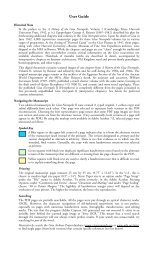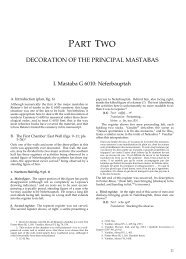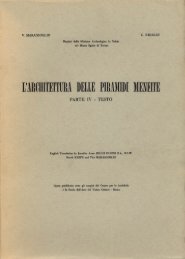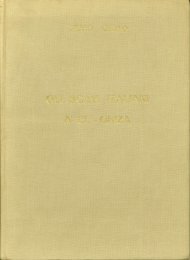The Discovery of the Osiris Shaft at Giza - Giza Archives Project
The Discovery of the Osiris Shaft at Giza - Giza Archives Project
The Discovery of the Osiris Shaft at Giza - Giza Archives Project
Create successful ePaper yourself
Turn your PDF publications into a flip-book with our unique Google optimized e-Paper software.
<strong>The</strong><br />
Archaeology and<br />
Artaf<br />
Ancient Egypt<br />
Essays in Honor <strong>of</strong> David B. O'Conno<br />
Volume I<br />
Edited by<br />
Zahi A. Hawass<br />
and Janet Richards
<strong>The</strong><br />
Archaeology and<br />
Artaf<br />
Ancient Egypt<br />
Essays in Honor <strong>of</strong> David B. O'Connor<br />
ANNALES DU SERVICE DES ANTIQUITES DE L'EGYPTE<br />
. CAHIER N° 36<br />
Volume I<br />
Edited by<br />
Zahi A. Hawass<br />
and Janet Richards<br />
PUBLICATIONS DU CONSEIL SUPREME DES ANTIQUITES DE L'EGYPTE
]<br />
Graphic Designer<br />
Lourie, Margaret A.<br />
Director <strong>of</strong> Printing<br />
Safw<strong>at</strong>, Amal<br />
(CASAE 36) 2007<br />
©.CONSEIL SUPREME DES AmIQUITES DE L'EGYPTE, LE CAIRE, 2007<br />
All rights reserved. No part <strong>of</strong> this public<strong>at</strong>ion may be reproduced,<br />
stored in a retrieval system, or transmitted in any form<br />
or by any means, electronic, mechanical, photocopying, recording,<br />
or o<strong>the</strong>rwise, without <strong>the</strong> prior written permission <strong>of</strong> <strong>the</strong><br />
publisher.<br />
Dar el Kutub No. 5576/2007<br />
ISBN-I0 977-437-241-7<br />
ISBN-13 987-977-437-241-4<br />
ISSN 5576/2007<br />
IMPRIMERIE DU CONSEIL SUPREME DES ANTIQUITES
Volume I<br />
Preface<br />
ZAHI A. HAWASS<br />
Acknowledgments<br />
List <strong>of</strong> Abbrevi<strong>at</strong>ions<br />
David B. O'Connor: A Tribute<br />
H. S. SMITH<br />
An Archaeological Biography<br />
JANET RICHARDS<br />
Essays<br />
Contents<br />
MATIHEW DOUGlAS ADAMS, Household Silos, Granary Models, and Domestic<br />
Economy in Ancient Egypt<br />
xiii<br />
xv<br />
xvi<br />
xix<br />
xxi
Contents<br />
SUE D'AuRIA, <strong>The</strong> American Branch <strong>of</strong> <strong>the</strong> Egypt Explor<strong>at</strong>ion Fund 185<br />
ROSALIE DAVID, <strong>The</strong> lntem<strong>at</strong>ional Ancient Egyptian Mummy Tissue Bank:<br />
A 21 st Century Contribution to Paleo-p<strong>at</strong>hological and<br />
Paleo-pharmacological Studies 199<br />
DENISE DOXEY, A New Kingdom Pair St<strong>at</strong>ue in <strong>the</strong> University <strong>of</strong><br />
Pennsylvania Museum 215<br />
GUNTER DREYER, Wer war Menes? 221<br />
KATHERINE EATON, Memorial Temples in <strong>the</strong> Sacred Landscape <strong>of</strong><br />
Nineteenth Dynasty Abydos: An Overview <strong>of</strong> Processional<br />
Routes and Equipment 231<br />
YAHIA EL-MASRY, <strong>The</strong> Ptolemaic Town (Ptolemais) 251<br />
AHMED EL-SAWY, <strong>The</strong> Necropolis <strong>of</strong> Ancient Terenouthis (Kom Abou Bellou) 267<br />
RICHARD A. FAZZlNI, Some Objects Found before <strong>the</strong> First Pylon <strong>of</strong> <strong>the</strong><br />
Mut Temple 277<br />
LAUREL FLENTYE, <strong>The</strong> Mastabas <strong>of</strong> Ankh-haf (G7510) and Akhe<strong>the</strong>tep<br />
and Meretites (G7650) in <strong>the</strong> Eastem Cemetery <strong>at</strong> <strong>Giza</strong>:<br />
A Reassessment 291<br />
RENEE FRIEDMAN, New Observ<strong>at</strong>ions on <strong>the</strong> Fort <strong>at</strong> Hierakonpolis,<br />
Appendix by Dietrich Raue 309<br />
MELINDA HARTWIG, A ,Head <strong>of</strong> a Ramesside Queen from Abydos 337<br />
STEPHEN P. HARVEY, King Heq<strong>at</strong>awy: Notes on a Forgotten Eighteenth<br />
Dynasty Royal Name 343<br />
FEKRI A. HASSAN, Droughts, Famine and <strong>the</strong> Collapse <strong>of</strong> <strong>the</strong> Old Kingdom:<br />
Re-reading lpuwer 357<br />
ZAHI A. HAWASS, <strong>The</strong> <strong>Discovery</strong> <strong>of</strong> <strong>the</strong> <strong>Osiris</strong> <strong>Shaft</strong> <strong>at</strong> <strong>Giza</strong> 379<br />
ix
Contents<br />
COLIN A. HOPE, Egypt and 'Libya' to <strong>the</strong> End <strong>of</strong> <strong>the</strong> Old Kingdom:<br />
A View from Dakhleh Oasis 399<br />
SALIMA IKRAM, Animals in <strong>the</strong> Ritual Landscape <strong>at</strong> Abydos: A Synopsis 417<br />
RICHARD JASNOW, "Through Demotic Eyes:" On Style and Description<br />
in Demotic Narr<strong>at</strong>ives 433<br />
JANICE KAMRIN, Toward a New D<strong>at</strong>abase for <strong>the</strong> Egyptian Museum, Cairo 449<br />
Volume II<br />
NAGUIB KANAWATI, <strong>The</strong> W<strong>at</strong>chers/Dependents <strong>of</strong> Min <strong>of</strong> Akhmim<br />
in <strong>the</strong> Old Kingdom<br />
BARRY KEMP, <strong>The</strong> Orient<strong>at</strong>ion <strong>of</strong> Burials <strong>at</strong> Tell el-Amama 21<br />
PETER LAcovARA, A Rishi C<strong>of</strong>fm from <strong>Giza</strong> and <strong>the</strong> Development <strong>of</strong><br />
This Type <strong>of</strong> Mummy Case 33<br />
ANTHONY LEAHY, Tomb Relief Carving <strong>at</strong> Abydos in <strong>the</strong> Seventh Century BC 39<br />
MARK LEHNER AND FREYA SADARANGANI, Beds for Bowabs in a Pyramid City 59<br />
RONALD J. LEPROHON, "Opening" in <strong>the</strong> Pyramid Texts 83<br />
CHRISTINE LI LYQU 1ST, Reflections on Mirrors 95<br />
MICHELLE MARLAR, Sex as a Votive Offering <strong>at</strong> <strong>the</strong> <strong>Osiris</strong> Temple 111<br />
GEOFFREY T. MARTIN, <strong>The</strong> Early Dynastic Necropolis <strong>at</strong> North Saqqara:<br />
<strong>The</strong> Unpublished Excav<strong>at</strong>ions <strong>of</strong>W. B. Emery and C. M. Firth 121<br />
HEATHER LEE MCCARTHY, <strong>The</strong> Beit el-Wali Temple <strong>of</strong> Ramesses 11:<br />
A Cosmological Interpret<strong>at</strong>ion 127<br />
x
Contents<br />
ROBERT S. MERRILLEES, Egyptological Ramblings Down Under 147<br />
A. J. MILLS, Where Are We Going? 157<br />
ANGElA MILWARD-JONES, A Unique Design on a Faience Bowl from Abydos 161<br />
ELLEN F. MORRIS, On <strong>the</strong> Ownership <strong>of</strong> <strong>the</strong> Saqqara Mastabas and <strong>the</strong><br />
Allotment <strong>of</strong> Political and ldeological Power <strong>at</strong> <strong>the</strong> Dawn<br />
<strong>of</strong> <strong>the</strong> St<strong>at</strong>e 171<br />
KAROL MYSLIWIEC, <strong>The</strong> Scheme 2 x 4 in <strong>the</strong> Decor<strong>at</strong>ion <strong>of</strong><br />
Old Kingdom Tombs 191<br />
ADElA OPPENHEIM, Three Deities in Procession: A Relief Block from <strong>the</strong><br />
Pyramid Complex <strong>of</strong> Senwosret 11 <strong>at</strong> Lahun in <strong>the</strong><br />
Metropolitan Museum <strong>of</strong> Art 207<br />
R. B. PARKINSON AND DETLEF FRANKE, A Song for Sarenput: Texts from<br />
Qubbet el-Hawa Tomb 36 219<br />
DIANA CRAIG PATCH, Third Intermedi<strong>at</strong>e Period Burials <strong>of</strong> Young<br />
Children <strong>at</strong> Abydos 237<br />
MARY-ANN POULS WEGNER, A Third lntermedi<strong>at</strong>e Period Burial<br />
'Ad Sanctos' <strong>at</strong> Abydos 257<br />
STEPHEN QUIRKE, Labour <strong>at</strong> Lahun 273<br />
ALI RADWAN, Concerning <strong>the</strong> Cult <strong>of</strong> Amenhotep 111 after His De<strong>at</strong>h 289<br />
DONALD B. REDFORD, Some Toponyms and Personal Names Rel<strong>at</strong>ing<br />
to <strong>the</strong> Sea Peoples 299<br />
CAROL REDMOUNT, El Hibeh: A Brief Overview 303<br />
JANET RICHARDS, <strong>The</strong> Archaeology <strong>of</strong> Excav<strong>at</strong>ions and <strong>the</strong> Role <strong>of</strong> Context 313<br />
xi
Contents<br />
GAY ROBINS, <strong>The</strong> Decor<strong>at</strong>ive Program in <strong>the</strong> Tomb <strong>of</strong> Tutankhamun (KV 62) 321<br />
GERRY D. Scon, III, Two Ceremonial Palette Fragments in <strong>the</strong> Collection<br />
<strong>of</strong> <strong>the</strong> San Antonio Museum <strong>of</strong> Art 343<br />
STEPHAN JOHANNES SEIDLMAYER, People <strong>at</strong> Beni Hassan: Contributions to<br />
a Model <strong>of</strong> Ancient Egyptian Rural Society 351<br />
ALM EL-DIN M. SHAHEEN, "W<strong>at</strong>er Carrier" or <strong>the</strong> Like in <strong>the</strong> Ancient<br />
Egyptian Sources and lts Resemblance to Dilmun Glyptic Art 369<br />
JJ SHIRLEY, <strong>The</strong> Life and Career <strong>of</strong> Nebamun, <strong>the</strong> Physician <strong>of</strong><br />
<strong>the</strong> King in <strong>The</strong>bes 381<br />
DAVID P. SILVERMAN AND JENNIFER HOUSER WEGNER, A L<strong>at</strong>e Egyptian Story<br />
in <strong>the</strong> Penn Museum 403<br />
RAINER STADELMANN, King Huni: His Monuments and His Place in<br />
<strong>the</strong> History <strong>of</strong> <strong>the</strong> Old Kingdom 425<br />
CHIP VINCENT, lntem<strong>at</strong>ional Conserv<strong>at</strong>ion Methodology,<br />
Practice and Ethics and <strong>The</strong>ir Applic<strong>at</strong>ion <strong>at</strong> <strong>the</strong> American<br />
Research Center in Egypt's Conserv<strong>at</strong>ion <strong>Project</strong> <strong>at</strong> Abydos 433<br />
DEBORAH VISCHAK, ldentity in/<strong>of</strong> Elephantine: <strong>The</strong> Old Kingdom Tombs<br />
<strong>at</strong> Qubbet el Hawa 443<br />
JOSEF WEGNER, From Elephant-Mountain to Anubis-Mountain?<br />
A <strong>The</strong>ory on <strong>the</strong> Origins and Development <strong>of</strong> <strong>the</strong> Name Abdju 459<br />
xii
<strong>The</strong> <strong>Discovery</strong> <strong>of</strong> <strong>the</strong> <strong>Osiris</strong> <strong>Shaft</strong> <strong>at</strong> <strong>Giza</strong><br />
Zahi A. Hawass<br />
Supreme Council <strong>of</strong>Antiquities<br />
lam very happy to write this article about one <strong>of</strong> my most important discoveries <strong>at</strong> <strong>Giza</strong> in honor<br />
<strong>of</strong> Dr. David O'Connor. I learned much from this gre<strong>at</strong> scholar about <strong>the</strong> field <strong>of</strong> Egyptology<br />
when I earned my doctor<strong>at</strong>e <strong>at</strong> <strong>the</strong> University <strong>of</strong> Pennsylvania. He gave generously <strong>of</strong> his time<br />
and knowledge, and helped me build a strong found<strong>at</strong>ion as an Egyptologist, which has helped<br />
me considerably in my career. I always say th<strong>at</strong> if I am a good Egyptologist, it is due to David<br />
O'Connor.<br />
As students, we always valued David O'Connor's interpret<strong>at</strong>ion <strong>of</strong> Egyptian history and his<br />
analysis <strong>of</strong> artifacts as well as his contribution to <strong>the</strong> d<strong>at</strong>ing <strong>of</strong> Pharaonic cemeteries. David<br />
O'Connor was able to gain <strong>the</strong> love <strong>of</strong> his students because <strong>of</strong> his honesty and scholarship. <strong>The</strong><br />
help th<strong>at</strong> he gave to all his students during our own studies and subsequent careers also makes<br />
us love him. <strong>The</strong> knowledge and discipline he has given to those <strong>of</strong> us fortun<strong>at</strong>e to be his students<br />
has helped many to get jobs in <strong>the</strong> field. David O'Connor is one <strong>of</strong> <strong>the</strong> few people th<strong>at</strong> I<br />
respect completely. I still seek his advice in m<strong>at</strong>ters th<strong>at</strong> concern my work, now th<strong>at</strong> I serve as <strong>the</strong><br />
Secretary General <strong>of</strong> <strong>the</strong> Supreme Council <strong>of</strong> Antiquities. It is to David O'Connor th<strong>at</strong> I dedic<strong>at</strong>e<br />
this article.<br />
Introduction<br />
In 1945, Abdel Moneim Abu Bakr learned th<strong>at</strong> guides <strong>at</strong> <strong>Giza</strong> were swimming in and drinking<br />
from <strong>the</strong> w<strong>at</strong>er <strong>of</strong> an underground shaft. He discovered this shaft, and its <strong>at</strong>tached chambers,<br />
under <strong>the</strong> causeway <strong>of</strong> Khafre (Fig. )). However, he never excav<strong>at</strong>ed or published it. In subsequent<br />
years, <strong>the</strong> rising w<strong>at</strong>er table in <strong>the</strong> shaft prevented scholars from studying it fur<strong>the</strong>r and interpreting<br />
its function. Workmen responsible for <strong>the</strong> resthouse <strong>of</strong> Cairo University, which is loc<strong>at</strong>ed<br />
south <strong>of</strong> Khafre's causeway and in <strong>the</strong> shadow <strong>of</strong> his pyramid, used <strong>the</strong> shaft as a w<strong>at</strong>er source,<br />
running a pipeline from <strong>the</strong> shaft to <strong>the</strong> resthouse. <strong>The</strong> shaft also continued to provide a summer<br />
swimming hole for <strong>the</strong> guides on <strong>the</strong> <strong>Giza</strong> Pl<strong>at</strong>eau. This shaft also became <strong>the</strong> center <strong>of</strong> <strong>at</strong>tention<br />
379
<strong>The</strong> <strong>Discovery</strong> <strong>of</strong> <strong>the</strong> <strong>Osiris</strong> <strong>Shaft</strong> <strong>at</strong> <strong>Giza</strong><br />
for New Age people, and <strong>the</strong>y spread rumors th<strong>at</strong> <strong>the</strong>re were tunnels leading from <strong>the</strong> shaft th<strong>at</strong><br />
connected with <strong>the</strong> Gre<strong>at</strong> Pyramid and <strong>the</strong> Sphinx.<br />
In <strong>the</strong> summer <strong>of</strong> 1999, I decided to excav<strong>at</strong>e this shaft to see if we could determine its function.<br />
1 We discovered three distinct shafts: <strong>the</strong> first leading to a single chamber; <strong>the</strong> second leading<br />
to one large chamber surrounded by six smaller chambers; and <strong>the</strong> third leading to a single<br />
large chamber with a sarcophagus in its center.<br />
<strong>The</strong> excav<strong>at</strong>ion proved to be very challenging mainly due to <strong>the</strong> dangerous n<strong>at</strong>ure <strong>of</strong> <strong>the</strong> work<br />
caused by <strong>the</strong> high w<strong>at</strong>er table. <strong>The</strong> chamber <strong>at</strong> <strong>the</strong> lowest level <strong>of</strong> <strong>the</strong> shaft was filled with w<strong>at</strong>er,<br />
and only <strong>the</strong> lid <strong>of</strong> a large, 'granite sarcophagus was visible. This w<strong>at</strong>er needed to be drained<br />
before we could excav<strong>at</strong>e properly. Esmail Osman, formerly <strong>the</strong> head <strong>of</strong> Osman Contractors,<br />
provided <strong>the</strong> machines to do this job. Pipes were run down <strong>the</strong> shaft to bring <strong>the</strong> w<strong>at</strong>er from <strong>the</strong><br />
lowest level up to <strong>the</strong> pl<strong>at</strong>eau. <strong>The</strong> noise from <strong>the</strong> pumping cre<strong>at</strong>ed extremely difficult working<br />
conditions. <strong>The</strong>re was also concern th<strong>at</strong> <strong>the</strong> drainage <strong>of</strong> <strong>the</strong> w<strong>at</strong>er might increase <strong>the</strong> size <strong>of</strong> <strong>the</strong><br />
cracks in <strong>the</strong> walls <strong>of</strong> <strong>the</strong> shaft. For this reason, plaster was applied to <strong>the</strong> cracks to stabilize <strong>the</strong>m<br />
and act as warning signs if any shifting took place.<br />
In order to determine <strong>the</strong> d<strong>at</strong>e <strong>of</strong> <strong>the</strong> shaft, it was decided to send young divers down into <strong>the</strong><br />
w<strong>at</strong>er <strong>of</strong> <strong>the</strong> shaft before draining it, to collect any extant artifacts. <strong>The</strong>se divers were securely<br />
<strong>at</strong>tached to safety ropes to avoid any risk <strong>of</strong> injury.<br />
We made a number <strong>of</strong> interesting discoveries during our excav<strong>at</strong>ions. As a result, we have<br />
been able to link <strong>the</strong> shaft complex with <strong>the</strong> god <strong>Osiris</strong>; we are now referring to this as <strong>the</strong> <strong>Osiris</strong><br />
<strong>Shaft</strong>.<br />
Loc<strong>at</strong>ion and Description <strong>of</strong> <strong>the</strong> <strong>Shaft</strong> Complex<br />
<strong>The</strong> entrance to <strong>the</strong> <strong>Osiris</strong> <strong>Shaft</strong> lies in <strong>the</strong> floor <strong>of</strong> a shallow tunnel th<strong>at</strong> runs from north to south<br />
under <strong>the</strong> causeway <strong>of</strong> Khafre, approxim<strong>at</strong>ely halfway between <strong>the</strong> Gre<strong>at</strong> Sphinx and Khafre's<br />
funerary temple (HAWASS 1987: 124).2 Access is through <strong>Shaft</strong> A near <strong>the</strong> western wall <strong>of</strong> <strong>the</strong><br />
tunnel (see Fig. I). <strong>The</strong> complex consists <strong>of</strong> three vertical shafts (<strong>Shaft</strong>s A, B, and C) leading to<br />
three levels (Levels 1,2, and 3) (Fig. 2). <strong>The</strong>re are additional chambers on Levels 2 and 3.<br />
Detailed Description <strong>of</strong> <strong>the</strong> Architectural Components <strong>of</strong> <strong>the</strong> Tomb<br />
<strong>The</strong> architectural components <strong>of</strong> <strong>the</strong> complex can be outlined as follows:<br />
1. <strong>Shaft</strong> A<br />
2. Level 1 with Chamber A<br />
3. <strong>Shaft</strong> B<br />
4. Level 2 with Chambers B through H<br />
5. <strong>Shaft</strong> C<br />
6. Level 3 with Chamber I<br />
<strong>Shaft</strong> A<br />
Dimensions:<br />
<strong>Shaft</strong> entrance: 2.60 x 3.00 m<br />
Depth: 9.62 m<br />
<strong>The</strong> first vertical shaft (<strong>Shaft</strong> A) is <strong>the</strong> main entrance to <strong>the</strong> <strong>Osiris</strong> Complex. It lies directly below<br />
Khafre's causeway, descending vertically from an opening 10.30 m from <strong>the</strong> south entrance and<br />
0.60 m from <strong>the</strong> western wall <strong>of</strong> <strong>the</strong> tunnel th<strong>at</strong> runs from north to south bene<strong>at</strong>h <strong>the</strong> causeway.<br />
381
<strong>The</strong> <strong>Discovery</strong> <strong>of</strong> <strong>the</strong> <strong>Osiris</strong> <strong>Shaft</strong> <strong>at</strong> <strong>Giza</strong><br />
<strong>The</strong> shaft adjoins <strong>the</strong> floor <strong>of</strong> <strong>the</strong> tunnel for a distance <strong>of</strong> c. 1.90 m from north to south and c.<br />
0.60 m from east to west. <strong>Shaft</strong> A, which is approxim<strong>at</strong>ely square in cross-section, descends for<br />
9.62 m, ending in a rectangular chamber (Chamber A) <strong>at</strong> level I (Fig. 3). <strong>The</strong> walls <strong>of</strong> <strong>Shaft</strong> A<br />
are roughly hewn.<br />
levelland Chamber A (see Fig. 3)<br />
Dimensions:<br />
Maximum height: 2.70 m (not level throughout)<br />
Length: 8.60 m<br />
Maximum width: 3.85 m (not level throughout)<br />
Level I consists <strong>of</strong> a rectangular chamber (Chamber A) extending north from <strong>the</strong> floor <strong>of</strong><br />
<strong>Shaft</strong> A. <strong>The</strong> entrance measures 2.35 x 2.50 m, and <strong>the</strong> chamber itself varies in height and width<br />
due to <strong>the</strong> uneven wall surfaces. <strong>The</strong> ro<strong>of</strong> slopes upward from its meeting with ,<strong>the</strong> shaft; <strong>the</strong><br />
chamber measures c. 2.65 high <strong>at</strong> <strong>the</strong> sou<strong>the</strong>rn end and 2.62 m <strong>at</strong> <strong>the</strong> nor<strong>the</strong>rn end, with a maximum<br />
height <strong>of</strong> 2.70 m. No artifacts were found <strong>at</strong> this level.<br />
<strong>Shaft</strong> B (see Figs. 2, 3)<br />
Dimensions:<br />
Mouth <strong>of</strong> <strong>the</strong> shaft: 1.90 x 1.90 m<br />
Depth <strong>of</strong> shaft: 13.25 m<br />
<strong>Shaft</strong> B descends from a point c. 1.10 m from <strong>the</strong> nor<strong>the</strong>rn wall, 0.80 m from <strong>the</strong> western<br />
wall, and 1.75 m from <strong>the</strong> eastern wall <strong>of</strong> Chamber A. It descends for 13.25 m before ending<br />
<strong>at</strong> Level 2. <strong>The</strong> walls <strong>of</strong> <strong>the</strong> shaft are roughly hewn. At a depth <strong>of</strong> approxim<strong>at</strong>ely 8.33<br />
m, a niche, 1.10 m high, J.80 m. wide, and 0.70 m deep, opens from <strong>the</strong> nor<strong>the</strong>rn wall <strong>of</strong><br />
<strong>the</strong> shaft.<br />
Level 2 with Chambers B-H (Figs. 4, 5)<br />
Dimensions <strong>of</strong> Chamber B:<br />
Height <strong>of</strong> <strong>the</strong> entrance into Chamber B: 2.25 m<br />
Width <strong>of</strong> entrance: 1.73 m<br />
Length from north-south: 6.80 m<br />
Width from east-west: 3.65 m<br />
Height: 2.60 m<br />
Chamber B extends north from a level 0.28 m lower than <strong>the</strong> floor <strong>of</strong> <strong>Shaft</strong> B. Six chambers<br />
(Chambers C to H) were carved <strong>of</strong>f <strong>of</strong> Chamber B: three to <strong>the</strong> west (C, 0, and E), one to <strong>the</strong> north<br />
I<br />
(Fl, and two to <strong>the</strong> east (G and H). Four <strong>of</strong> <strong>the</strong>se chambers contained sarcophagi and artifacts<br />
d<strong>at</strong>ing primarily to <strong>the</strong> 26th Dynasty.<br />
Description <strong>of</strong> <strong>the</strong> Side Chambers<br />
Western Chambers<br />
Chamber C<br />
Dimensions <strong>of</strong> Chamber C:<br />
Height: 1.58 m<br />
Width: 2.40 m<br />
Depth: 3.20 m<br />
Chamber C is loc<strong>at</strong>ed 0.40 m northwest <strong>of</strong> <strong>the</strong> exit from <strong>the</strong> second shaft. <strong>The</strong> floor <strong>of</strong> this<br />
383
Hawass<br />
Fig. 5: Photograph <strong>of</strong> Level 2<br />
looking north towards Chamber<br />
F.<br />
chamber was excav<strong>at</strong>ed from <strong>the</strong> south side. An anthropoid sarcophagus <strong>of</strong> granite was discovered,<br />
set into a pit th<strong>at</strong> had been cut into <strong>the</strong> floor.<br />
Dimensions <strong>of</strong> sarcophagus:<br />
Length: 210 em<br />
Width: 50 em<br />
Depth: 45 em<br />
<strong>The</strong> badly-decayed remains <strong>of</strong> a skeleton were discovered inside <strong>the</strong> sarcophagus, along with<br />
<strong>the</strong> remains <strong>of</strong> shabtis and pottery sherds from <strong>the</strong> 26th Dynasty. <strong>The</strong> shape <strong>of</strong> <strong>the</strong> sarcophagus<br />
d<strong>at</strong>es it to <strong>the</strong> 26th Dynasty.<br />
Chamber D<br />
Dimensions <strong>of</strong> Chamber D:<br />
Height: 2.20 m<br />
Width: 1.85 m<br />
Depth: 2.90 m<br />
Chamber D is loc<strong>at</strong>ed c. 1 m north <strong>of</strong> Chamber C and had not been explored prior to our<br />
expedition. A basalt sarcophagus in <strong>the</strong> style <strong>of</strong> <strong>the</strong> 26th Dynasty was discovered inside this<br />
chamber (see Fig. 5).<br />
Dimensions <strong>of</strong> sarcophagus:<br />
Length: 240 em<br />
Width: 123 cm<br />
Depth: 95 cm<br />
Depth <strong>of</strong> hollow: 67 cm<br />
Thickness <strong>of</strong> edges: 25 cm<br />
Lid <strong>of</strong> sarcophagus:<br />
Length: 265 cm<br />
Width: 114 cm<br />
Height: c. 30 cm<br />
A large number <strong>of</strong> 26th Dynasty shabtis and pottery sherds were discovered on <strong>the</strong> south side<br />
<strong>of</strong> <strong>the</strong> sarcophagus.<br />
386
<strong>The</strong> <strong>Discovery</strong> <strong>of</strong> <strong>the</strong> <strong>Osiris</strong> <strong>Shaft</strong> <strong>at</strong> <strong>Giza</strong><br />
Chamber E<br />
Entrance:<br />
Height: 2.40 m<br />
Width: 1.50 m<br />
Depth: 2.35 m<br />
Chamber E is loc<strong>at</strong>ed c. 0.85 m north <strong>of</strong> Chamber D. On <strong>the</strong> north side <strong>of</strong> <strong>the</strong> floor, 0.80 m<br />
from <strong>the</strong> nor<strong>the</strong>rn wall, is a small rectangular pit carved into <strong>the</strong> living rock.<br />
Dimensions <strong>of</strong> pit:<br />
Length: 125 cm<br />
Width: 45 cm<br />
Depth: 25 cm<br />
No o<strong>the</strong>r artifacts were discovered in this chamber.<br />
Nor<strong>the</strong>rn Chamber<br />
Chamber F<br />
Dimensions <strong>of</strong> Chamber F:<br />
Height: 2.45 m<br />
Width: 2.10 m<br />
Depth: 2.55 m<br />
Chamber F was cut directly from <strong>the</strong> north wall <strong>of</strong> Chamber B, with its western wall c. 1.20<br />
m from <strong>the</strong> western wall <strong>of</strong> Chamber B.<br />
Eastern Chambers<br />
Chamber G<br />
Dimensions <strong>of</strong> Chamber G:<br />
Height: 2.43 m<br />
Width: 2.40 m<br />
Depth: 2.00 m from west to east<br />
Chamber G is cut into <strong>the</strong> east wall <strong>of</strong> Chamber B. This chamber has a niche, 1.75 m in width,<br />
1.38 m in depth, and 1.41 m in height, cut into <strong>the</strong> eastern wall. This contains a basalt sarcophagus,<br />
rectangular in shape with a curved front, which fills it completely and extends into <strong>the</strong> chamber.<br />
<strong>The</strong> remains <strong>of</strong> human bones, shabtis <strong>of</strong> blue faience, and pottery sherds, all d<strong>at</strong>ing to <strong>the</strong><br />
L<strong>at</strong>e Period, were found near <strong>the</strong> sarcophagus.<br />
Dimensions <strong>of</strong> sarcophagus:<br />
Length: 250 cm<br />
Width: 120 cm<br />
Height: 105 cm<br />
Lid <strong>of</strong> sarcophagus:<br />
Height: 26 cm<br />
Chamber H<br />
Dimensions:<br />
Height: 2.50 m<br />
Width: 1.60 m<br />
Depth: 2.40 m<br />
Chamber H is loc<strong>at</strong>ed c. 1 m south <strong>of</strong> Chamber G.<br />
387
Hawass<br />
<strong>Shaft</strong> C. <strong>The</strong> entrance to <strong>the</strong> third level is from <strong>the</strong> floor <strong>of</strong> a rectangular niche cut into <strong>the</strong> rock,<br />
similar in size and shape to <strong>the</strong> burial chambers, on <strong>the</strong> second level. This niche is loc<strong>at</strong>ed c. 0.90<br />
m south <strong>of</strong> Chamber H and is oriented sou<strong>the</strong>ast to northwest.<br />
Dimensions <strong>of</strong> niche:<br />
Height: 2.60 m<br />
Width: 2.30 m<br />
Depth: 3.20 m<br />
Into <strong>the</strong> walls <strong>of</strong> this niche were carved seven rectangular niches: four large ones, two each in<br />
<strong>the</strong> nor<strong>the</strong>ast and southwest walls; and three small, one in <strong>the</strong> nor<strong>the</strong>ast and two in <strong>the</strong> sou<strong>the</strong>ast<br />
walls. <strong>The</strong>se holes might have been used for lowering a large basalt sarcophagus down <strong>the</strong> shaft<br />
by using wooden beams.<br />
Dimensions oj shaft:<br />
North to ·south: 1.65 m<br />
East to west: 1.90 m<br />
Depth: 7.50 m<br />
Level 3 with Chamber I (Figs. 6, 7, 8). This is <strong>the</strong> main level <strong>of</strong> <strong>the</strong> complex. It consists <strong>of</strong> a<br />
large square chamber th<strong>at</strong> extends to <strong>the</strong> west <strong>of</strong> <strong>Shaft</strong> C. A large basalt sarcophagus stands in a<br />
w<strong>at</strong>er-filled emplacement in <strong>the</strong> center <strong>of</strong> this chamber.<br />
Dimensions:<br />
Length <strong>of</strong> eastern wall: 8.84 m<br />
Length <strong>of</strong> sou<strong>the</strong>rn wall: 8.60 m<br />
Length <strong>of</strong> western wall: 9.08 m<br />
Length <strong>of</strong> nor<strong>the</strong>rn wall: 9.20 m<br />
Description:<br />
Chamber I is a squarish chamber extending to <strong>the</strong> west <strong>of</strong> <strong>the</strong> floor <strong>of</strong> <strong>Shaft</strong> C. A narrow ledge<br />
runs partially around <strong>the</strong> interior <strong>of</strong> <strong>the</strong> walls <strong>of</strong> <strong>the</strong> chamber. In <strong>the</strong> center <strong>of</strong> <strong>the</strong> chamber is a<br />
rectangular emplacement, carved from <strong>the</strong> living rock, with <strong>the</strong> remains <strong>of</strong> square pillars <strong>at</strong> each<br />
<strong>of</strong> its four corners (see Fig. 6). This emplacement is <strong>at</strong> a distance <strong>of</strong> approxim<strong>at</strong>ely 1.5 m from<br />
<strong>the</strong> walls <strong>of</strong> <strong>the</strong> chamber, with <strong>the</strong> maximum distance almost 2 meters and <strong>the</strong> minimum distance<br />
about 1.3 meters; <strong>the</strong> presence <strong>of</strong> this emplacement cre<strong>at</strong>es <strong>the</strong> effect <strong>of</strong> a trench running between<br />
it and <strong>the</strong> chamber walls. <strong>The</strong> walls <strong>of</strong> <strong>the</strong> emplacement are approxim<strong>at</strong>ely 2 meters thick, and<br />
<strong>the</strong> remnants <strong>of</strong> <strong>the</strong> pillars or pillar bases, also carved into <strong>the</strong> living rock, are approxim<strong>at</strong>ely 1.5<br />
meters square. <strong>The</strong> walls <strong>of</strong> <strong>the</strong> emplacement are uneven.<br />
Dimensions <strong>of</strong> emplacement:<br />
North wall: 5.24 m<br />
East wall: 5.56 m<br />
South wall: 5.76 m<br />
West wall: 6.04 m<br />
<strong>The</strong> floor <strong>at</strong> <strong>the</strong> entrance to <strong>the</strong> chamber, stretching from <strong>the</strong> exit <strong>of</strong> <strong>the</strong> pit to <strong>the</strong> central<br />
emplacement, has been left <strong>at</strong> <strong>the</strong> level <strong>of</strong> <strong>the</strong> emplacement. Thus <strong>the</strong> trench cre<strong>at</strong>ed by <strong>the</strong><br />
emplacement, takes <strong>the</strong> shape <strong>of</strong> a house plan, <strong>the</strong> hierogyph pro This trench is generally filled<br />
with w<strong>at</strong>er. <strong>The</strong> burial chamber is thus similar to an island with <strong>the</strong> sarcophagus in <strong>the</strong> middle<br />
surrounded by w<strong>at</strong>er in <strong>the</strong> shape <strong>of</strong> <strong>the</strong> pr sign. (see Figs. 7, 8)<br />
In <strong>the</strong> center <strong>of</strong> <strong>the</strong> emplacement is a rectangular pit.<br />
388
Hawass<br />
FAULKNER 1962: 146).8 For this reason, it is logical th<strong>at</strong> <strong>the</strong>re should be a tomb <strong>at</strong> <strong>Giza</strong> for <strong>Osiris</strong>.<br />
<strong>The</strong> w<strong>at</strong>er-filled trench around <strong>the</strong> burial emplacement, which is in <strong>the</strong> shape <strong>of</strong> <strong>the</strong> hieroglyph<br />
for house, pI', reinforces this identific<strong>at</strong>ion.<br />
Symbolically, <strong>Osiris</strong> would have been buried inside <strong>the</strong> shaft to give power to <strong>the</strong> kings who<br />
were buried under <strong>the</strong> nearby pyramids. In this respect, <strong>the</strong> kings who were buried in <strong>the</strong>ir own<br />
"underground tunnels" would gain power like <strong>Osiris</strong>.<br />
Fur<strong>the</strong>r support for <strong>the</strong> identific<strong>at</strong>ion <strong>of</strong> this shaft complex as <strong>the</strong> tomb/house <strong>of</strong> <strong>Osiris</strong> comes<br />
from <strong>the</strong> "Inventory Stele," found in <strong>the</strong> chapel <strong>of</strong> queen's pyramid G I-c, which was converted<br />
into a temple to Isis in <strong>the</strong> 21 st Dynasty and enlarged in <strong>the</strong> 26th Dynasty (for <strong>the</strong> "Inventory<br />
Stele," see HASSAN 1953: 113, fig. 80, pis. LV, LVI; ZlVlE-COCHE 1991: 219, 240). <strong>The</strong> relevant portion<br />
<strong>of</strong> this text, which d<strong>at</strong>es to <strong>the</strong> 26th Dynasty, says:<br />
Khufu ... found <strong>the</strong> house <strong>of</strong> Isis, Mistress <strong>of</strong> <strong>the</strong> Pyramid, ... on <strong>the</strong> northwest <strong>of</strong> <strong>the</strong> house<br />
<strong>of</strong> <strong>Osiris</strong>, Lord <strong>of</strong> Rosta... (BREASTED 1906: 85, §180)<br />
<strong>The</strong> <strong>Osiris</strong> <strong>Shaft</strong> is directly south <strong>of</strong> queen's pyramid G l-c. Graffiti on <strong>the</strong> surface <strong>of</strong> this<br />
pyramid, originally built for a queen <strong>of</strong> Khufu's named Henutsen (HAWASS 1987: 42; LEHNER 1997:<br />
116),9 refer to it as <strong>the</strong> burial place <strong>of</strong> Isis (see WILDUNG 1969: 177-178, 186-188 for <strong>the</strong> graffiti).<br />
Tj len, in <strong>the</strong> L<strong>at</strong>e Period, pyramid GI-c was changed to <strong>the</strong> symbolic burial <strong>of</strong> Isis, which faced<br />
south towards <strong>the</strong> symbolic burial <strong>of</strong> <strong>Osiris</strong>.<br />
South <strong>of</strong> <strong>the</strong> <strong>Giza</strong> Pyramids and north <strong>of</strong> <strong>the</strong> proposed ring road (which <strong>the</strong> Egyptian Ministry<br />
<strong>of</strong> Construction wanted to build but was stopped in order to protect <strong>the</strong> pyramids) is a cemetery<br />
<strong>of</strong> <strong>Osiris</strong> united with Sokar as Sokar-<strong>Osiris</strong>, d<strong>at</strong>ing from <strong>the</strong> Ptolemaic and Roman periods. 10 <strong>The</strong><br />
cemetery consists <strong>of</strong> a series <strong>of</strong> small pits in <strong>the</strong> ground. A st<strong>at</strong>ue <strong>of</strong> a mummified Sokar-<strong>Osiris</strong><br />
with an erection was discovered in a wooden box in one <strong>of</strong> <strong>the</strong>se pits. II <strong>The</strong> erection is a direct<br />
reference to resurrection in <strong>the</strong> afterlife. Faience and symbolic vessels were also found near <strong>the</strong><br />
tombs. This alS'
<strong>The</strong> <strong>Discovery</strong> <strong>of</strong> <strong>the</strong> <strong>Osiris</strong> <strong>Shaft</strong> <strong>at</strong> <strong>Giza</strong><br />
Appendix: Finds<br />
<strong>The</strong> amulets and bead were not discovered in situ. Most <strong>of</strong> <strong>the</strong> finds can be d<strong>at</strong>ed to <strong>the</strong> L<strong>at</strong>e<br />
Period.<br />
1. Amulet in <strong>the</strong> shape <strong>of</strong> two fingers (<strong>Giza</strong> Magazine, GZ.PA.509) (Fig. 9, left)<br />
M<strong>at</strong>erial: obsidian<br />
Length: 10.8 em<br />
Width below: 2.7 em<br />
Width above: 2.2 em<br />
Thickness below: 0.9 cm<br />
Thickness above: 0.7 em<br />
This amulet is in <strong>the</strong> shape <strong>of</strong> two fingers showing <strong>the</strong> index and middle finger. <strong>The</strong> nails<br />
are deline<strong>at</strong>ed by two incised round lines, and <strong>the</strong> joints are also defined. <strong>The</strong> fingers are well<br />
polished. <strong>The</strong> amulet was put in <strong>the</strong> opened area <strong>of</strong> <strong>the</strong> stomach during mummific<strong>at</strong>ion.<br />
2. Amulet in <strong>the</strong> shape <strong>of</strong> two fingers (<strong>Giza</strong> Magazine, GZ.PA.51O)<br />
M<strong>at</strong>erial: obsidian<br />
Length: 8 em<br />
Width along <strong>the</strong> top <strong>of</strong> <strong>the</strong> nails: 2 cm<br />
Width <strong>at</strong> <strong>the</strong> bottom <strong>of</strong> <strong>the</strong> fingers: .9 cm<br />
Thickness <strong>at</strong> <strong>the</strong> bottom: 1.1 cm<br />
Similar to number I (GZ.PA.509)<br />
No. 509<br />
o 3 4 5<br />
393<br />
(A)<br />
( B)<br />
No. 511<br />
Fig. 9: Drawing<br />
<strong>of</strong> GZ.PA.509 (left)<br />
and GZ.PA.511<br />
(right).
<strong>The</strong> <strong>Discovery</strong> <strong>of</strong> <strong>the</strong> <strong>Osiris</strong> <strong>Shaft</strong> <strong>at</strong> <strong>Giza</strong><br />
This amulet in <strong>the</strong> shape <strong>of</strong> <strong>the</strong> hieroglyph wIg is made <strong>of</strong> green faience. It has a hole for<br />
hanging.<br />
7. Amulet in <strong>the</strong> shape <strong>of</strong> Atef plumes (<strong>Giza</strong> Magazine. GZ.PA.515) (Fig. 10, center left)<br />
M<strong>at</strong>erial: Faience<br />
Measurements: (<strong>Giza</strong> Magazine, <strong>Giza</strong> register no. 515)<br />
Length: 2.8 cm<br />
Width: 1.3 em<br />
Thickness: 0.4 em<br />
This amulet is in <strong>the</strong> shape <strong>of</strong> <strong>the</strong> Atef plumes and is made <strong>of</strong> blue faience. <strong>The</strong> wearing <strong>of</strong><br />
<strong>the</strong> amulet with Atef plumes identified <strong>the</strong> deceased with <strong>the</strong> gods.<br />
8. Amulet in <strong>the</strong> shape <strong>of</strong> Atef plumes (<strong>Giza</strong> Magazine. GZ.PA.516) (Fig. 10, left)<br />
Measurements: (<strong>Giza</strong> Magazine, <strong>Giza</strong> register no. 516)<br />
Length: 0.3 em<br />
Width: 1.6 em<br />
Thickness: 0.3 em<br />
See no. 7 (GZ.PA.515)<br />
9. Amulet in <strong>the</strong> shape <strong>of</strong> Horus (<strong>Giza</strong> Magazine, GZ.PA.517)<br />
M<strong>at</strong>erial: Basalt?<br />
Notes:<br />
Length: 2.5 em<br />
Width: 0.5 em<br />
This small amulet represents Horus with <strong>the</strong> body <strong>of</strong> a man and a head <strong>of</strong> a<br />
Hawk. A pillar supports <strong>the</strong> back <strong>of</strong> <strong>the</strong> amulet.<br />
<strong>The</strong>re are many people who assisted me in <strong>the</strong> excav<strong>at</strong>ion <strong>of</strong> this shaft, in particular archaeologists Mahmoud<br />
Aflfl, Mansour Boraik, and Tarek El Awady; architects Abdel Hamid Kotb and Nevine el Magrabi;<br />
and Noha Abdel HafIz. Reis Ahmed and Talal EI-Krity came from Saqqara to move heavy objects. I would<br />
also like to thank Georges Castel from <strong>the</strong> French Institute in Cairo, who did an excellent job mapping <strong>the</strong><br />
architecture <strong>of</strong> <strong>the</strong> tomb.<br />
2 This tunnel is similar to one th<strong>at</strong> runs under <strong>the</strong> causeway <strong>of</strong> Khufu. <strong>The</strong>se tunnels most likely served<br />
as access points for priests and o<strong>the</strong>r mortuary personnel, so th<strong>at</strong> <strong>the</strong>y would not need to go all <strong>the</strong> way<br />
around <strong>the</strong> causeway. Hawass discusses <strong>the</strong> tunnel under Khufu's causeway.<br />
3 <strong>The</strong> identific<strong>at</strong>ion <strong>of</strong> this tomb as <strong>the</strong> tomb <strong>of</strong> <strong>Osiris</strong> was announced by <strong>the</strong> author on many occa<br />
sions through <strong>the</strong> press and also in public<strong>at</strong>ions. It is also published by Bojana Mojsov as <strong>the</strong> tomb<br />
<strong>of</strong> <strong>Osiris</strong> without giving credit to <strong>the</strong> discoverer or <strong>the</strong> person who identified <strong>the</strong> tomb as <strong>the</strong> tomb<br />
<strong>of</strong> <strong>Osiris</strong>.<br />
4 <strong>The</strong> name <strong>of</strong> <strong>Osiris</strong> first appears in royal and priv<strong>at</strong>e monuments in <strong>the</strong> 5th Dynasty. On royal monuments,<br />
it first occurs on a fragment from <strong>the</strong> pyramid temple <strong>of</strong> Djedkare Isesi <strong>at</strong> Saqqara. See BAER 1960: 297;<br />
GRIFFffilS 19BO: 44, 236-237, frontispiece; GRrFFffilS 2001: 615. <strong>Osiris</strong>'s name is first mentioned in priv<strong>at</strong>e<br />
funerary texts <strong>of</strong> King Neuserre <strong>of</strong> <strong>the</strong> 5th Dynasty (GRIFFffilS 19BO: 44). <strong>The</strong> name <strong>of</strong> <strong>Osiris</strong> also appears<br />
395
<strong>The</strong> <strong>Discovery</strong> <strong>of</strong> <strong>the</strong> <strong>Osiris</strong> <strong>Shaft</strong> <strong>at</strong> <strong>Giza</strong><br />
HORNUNG, E.<br />
1990 <strong>The</strong> Valley <strong>of</strong> <strong>the</strong> Kings: Horizon <strong>of</strong>Eternity, trans. D. Warburton. New York.<br />
LAPP, G. AND NIWlNSKl, A.<br />
2001 C<strong>of</strong>fins, Sarcophagi, and Cartonnages. In D. B. REDFORD (ED.), OEAE Vol. 1: 279-287. Oxford.<br />
LEHNER, M.<br />
1997 <strong>The</strong> Complete Pyramids. London.<br />
MOJsov, B.<br />
2005 <strong>Osiris</strong>: De<strong>at</strong>h and Afterlife <strong>of</strong> a God. Malden.<br />
PORTER, B. and Moss, R. L. B.<br />
1991 Topographical Bibliography <strong>of</strong>Ancient Egyptian Hieroglyphic Texts, Reliefs, and Paintings. VI. Upper<br />
Egypt: Chief Temples (Excluding <strong>The</strong>bes). Abydos, Dendera, Esna, Edju, Keirn Ombo and Philae.<br />
Oxford.<br />
RAWLINSON, G. (trans.)<br />
1996 Herodotus, <strong>The</strong> Histories. Hertfordshire.<br />
WEGNER, J. W.<br />
2001 Abydos. In D. B. REDFORD (ED.), OEAE Vol 1: 7-12. Cairo.<br />
WILDUNG, D.<br />
1969 Die Rolle iigyptischer Konige im BewulJtsein ihrer Nachwelt, part 1, Posthume Quellen iiber',die<br />
Konige der ersten vier Dynastien. MAs 17. Berlin.<br />
YOYOTIE, J.<br />
1961 Les Bousiris et les Abousir d'Egypte. GLECS 8: 57-60.<br />
ZIVlE, C. M.<br />
1976 <strong>Giza</strong> au deuxieme millenaire. BdE 70. Cairo.<br />
ZIVlE-COCHE, C. M.<br />
1991 <strong>Giza</strong> au premier millenaire: autour du temple d'lsis, dame des pyramides. Boston.<br />
397



